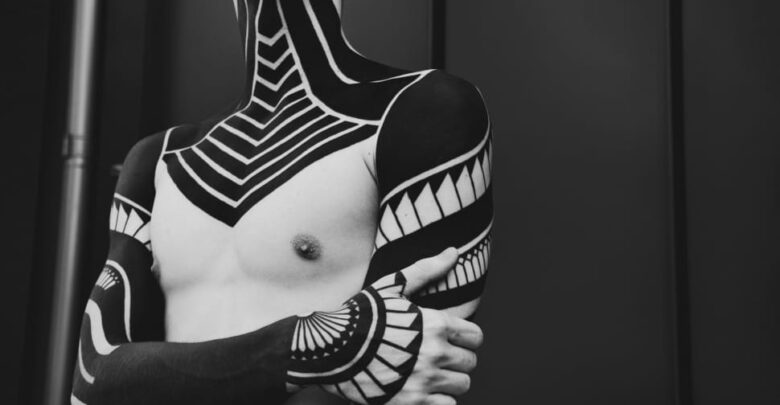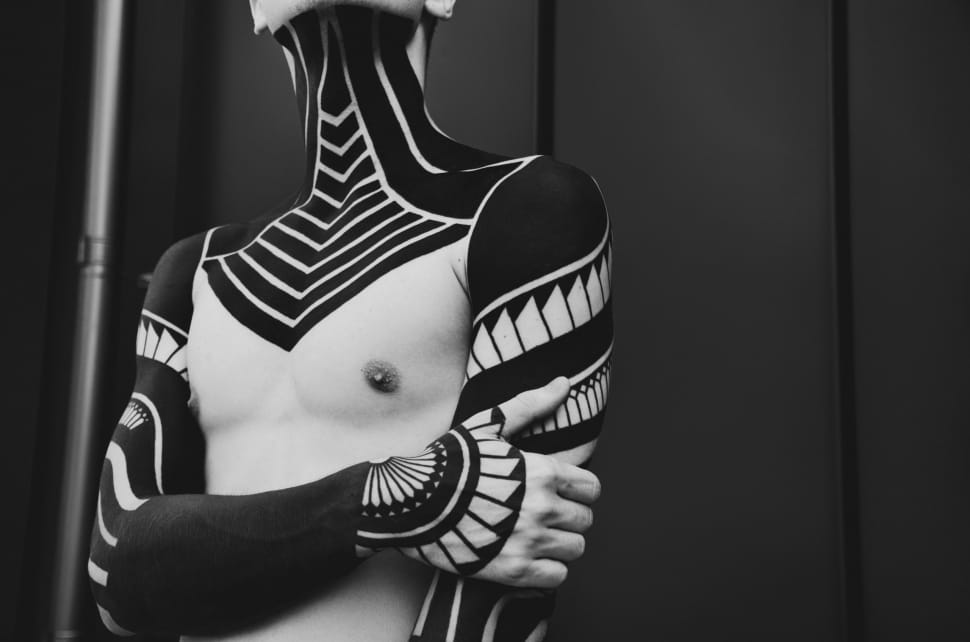The Evolution of African body Markings and Tattoos

More than merely skin deep, tattoos In Africa and body marks are visible. But, when we imagine tattoos, we typically see them on people with white complexion or caramel (African American) skin.
We have recently started accepting exquisite handprints and wonderful body artworks created for African black skin.
Tattoos In Africa are a crucial component of African makeup, just as the tribal hair on the continent. Several African tattoo designs have profound symbolic implications and are of great importance to our diverse culture.
For millennia, African tribes have decorated their bodies with various body tattoos and artworks. Often, they included body painting, shaving, and piercing.
We’ll talk about the origins and significance of African tribal insignia in this post.

The Origins of African Tattoos/Tattoos In Africa
Amazingly, traditional African tattoos have existed for thousands of years and have a broad range of symbolic meanings, including wearing of them to ward off evil spirits, display accomplishments, and express allegiance to certain tribes or organizations.
There are a few significant exceptions to the general lack of comprehensive research on African tattoo culture and history.
First discovered as simple ink drawings on mummified female corpses from about the year 2000 BCE, historical tattoos In Africa were first discovered by anthropologists.
Anthropologists hypothesized that these ladies employed their tattoo marks to promote fertility and youth. This happened as a result of the tattoos’ designs and locations on the bodies.
These patterns were found on the abdomen and pelvis of the women who had them. The oldest tattoos found on men date only as far back as 1300 BCE.
The ancient goddess of battle and weaving Neith was considered to be represented by them.
In addition to Egypt, mummies from other African nations have also been discovered to contain tattoos, many of which are believed to have been made to express dedication to sun worship.
On the face, arms, legs, and navel area, they typically discovered extremely straightforward tattoos with straight lines or circular designs.
Also Read: The Art of Body Painting: Traditional African Face Painting & Body Painting
The Art of Body Painting: Traditional African Face Painting & Body Painting
Inked people in North Africa
In the past, many people in North Africa, particularly in Egypt, Libya, Algeria, and Morocco, had African body marks.
Yet, in more recent times, Islamic civilizations in North Africa have started to see the act of getting a tattoo or another type of engravement as disrespectful and impure.
So, some tribes in these areas create temporary tattoos using henna designs. In actuality, Muslim women are encouraged to use henna to color their nails as a sign of their femininity. Some ladies also use it to tell a man’s hands from a woman’s.
This custom is also gaining popularity right now and has unquestionably established itself as a key component of Islamic brides’ bridal makeup.
Yet, henna decorations have also been used to decorate women’s bodies as part of social and holiday festivities going back as far as 9000 BCE in ancient Egypt, particularly in the context of fertility and marriage ceremonies.
It’s important to keep in mind, though, that henna art is not a genuine tattoo. Tattoos last a lifetime. Henna, on the other hand, just rests momentarily on the skin’s surface.
Henna may also be used to color hair, nails, silk, leather, and wool.
The usage of traditional African tattoos is still widespread in North African communities, including those in Egypt, Libya, Tunisia, Algeria, and Morocco, according to literature from the 20th century.
Sub-Saharan Africa: `Tattoos In Africa
Scarification is the most typical form of tribal body modification in Sub-Saharan Africa. In this instance, sharp objects are used to produce cuts into the skin that are deep enough to leave a lasting mark.
They would cut off patterns and forms from pieces of skin so that when the skin recovered and scarred, it would leave a permanent shape or pattern.
The primary goal of scarification varied depending on the location. Yet, the majority of people think that scarification—especially when it was applied to the face—made the wearer less appealing to the spirit of death.
The procedure of skin scarification, however, is terrifying. It can also be risky since people often die if they don’t receive prompt treatment for infections they get from puncture wounds due to a lack of aftercare.
Yet, the Sahel area, which extends from Senegal to the Red Sea, is where scarification is most noticeable.
The Fulani are one of the Sahel’s tribes with the most tattoos. They are the largest tribe there by a similar margin.
Sub-Saharan Africa: History, Geography, Politics and Racist Undertone
Sub-Saharan Africa: History, Geography, Politics and Racist Undertone
Body markings on Africans and the Slave Trade
The usage of these tribal tattoos is thought to have expanded during the Atlantic Slave Trade, despite the lack of information on the number of tribes, historical eras, and genuine importance of African body markings.
It was rumored that tribal members who were transported as slaves had markings on them to help rescuers or freedmen recognize them.
These tribal tattoos were also created so that, when a person relocated to a distant country, their identities, ethnicity, religious connections, social rank, life events, and accomplishments would not be lost.
Soon, slave traffickers and masters caught on and started classifying their slaves according to their African body marks.
They could command high wages for slaves who wore these markings designating them as brave. Also, the African body tattoos aided in the arrest of runaway slaves and the need that slaveowners to pay taxes.
Also Read: The Slave Trade in Africa: The Atlantic Slave Trade
Current Tattoo Trends in African Cultures
More recently, the cicatrization procedure—which involves scarification and tattooing—has been the focal point of these traditional African tattooing techniques.
Hence, the cicatrization technique would entail both skin-cutting to form the scar tissue and tattooing to provide a very black look using ash or soot as the color pigments.
These wounds are frequently reopened in order to put pearls and stones beneath the skin for a more pronounced and elevated look.
The process of cicatrization is employed as a ceremonial rite of passage in many cultures.
As boys reach puberty, they would receive those markings, and a few years later, as they near adulthood, the wounds would be reopened to add the pearls and stones.
Traditional African tattoos with additional symbolic meanings
As was previously stated, tattoos In Africa are also used in many African communities to establish social rank and hierarchies.
Within their social groupings or tribes, those with very simple tattoos (simple lines and forms) or those without tattoos are seen as low-ranking.
High-ranking officials, such as Chiefs, on the other hand, would demonstrate their status as prominent figures by donning extensive and complex African body marks.
Naturally, a person’s fundamental tattoos will be altered as they rise in rank to become more intricate and elaborate.
Also Read: African Masks: Intermediaries between the Living and Supernatural Worlds
African Masks: Intermediaries between the Living and Supernatural Worlds
Lasting Thoughts on Tattoos In Africa
It’s crucial to understand that not all tattoos are ceremonial, tribal, or religious. Many people today just get tattoos for aesthetic reasons.
Tattoos In Africa, however, may undoubtedly be regarded as one of the tattoo culture’s richest beginnings.
Due to the fact that we no longer produce plain markings but rather artworks that depict African history and culture, African tattoos are becoming increasingly popular nowadays.
Investigate the meaning of the tattoo the next time you meet someone with one. Perhaps there’s an interesting tale behind that stunning design.
In any case, Africa is a sizable continent with a totally distinct culture. Be aware that a single African tattoo design may represent something quite different in one place than it does in another.





